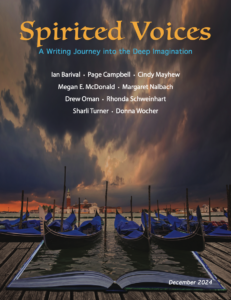________________________________________
“I find that most people know what a story is
until they sit down to write one.”
~ Flannery O’Connor
________________________________________
A few months ago I was invited to join a panel of writers at a local bookstore to talk about our creative process. We’d all recently had poems or stories published. Mine was a nonfiction piece about a cross-country trip I’d made with a woman friend right after college, called “New York to California: An I Ching Travel Adventure.”
 The panel moderator asked me, “How do you transform a life experience into a story other people will want to read?” Good question, I thought. And one that had been on my mind when I submitted the story for publication. After all, countless tales have been written about dreadful car trips across the U.S. Do we need one more? I felt fortunate the editors had accepted my work.
The panel moderator asked me, “How do you transform a life experience into a story other people will want to read?” Good question, I thought. And one that had been on my mind when I submitted the story for publication. After all, countless tales have been written about dreadful car trips across the U.S. Do we need one more? I felt fortunate the editors had accepted my work.
The five brief points I offered the bookstore audience are ground rules I keep in mind when writing a story about my life. These rules were not intuitive to me when I started writing memoir years ago. I learned them through practice and plenty of feedback from a critique group. These are not the only rules for captivating readers, but they provide basic guidelines to make your story more compelling.
1. Know what to leave out.
When you write about your life, the temptation is to include too much. Why? Because it happened. Nearly everything about the events of your story can seem important and relevant—to you. And there’s no harm in piling these details into your early drafts. But your ultimate readers don’t want or need all that.
Keep your story contained and tightly focused. Trim the excess so the essence can shine through. My story began as a long letter to friends right after the trip. I’m sure even my friends skipped a few parts of that long version.
Remember that writing in general is a process of taking things out. When you write about your life, your closeness to the subject makes it hard to filter out the extraneous. Extra attention—and a good editor—will help you know what to cut.
2. Write in scenes, and start a scene one-third of the way into the action.
I heard novelist Ellen Sussman say this in a lecture years ago and it made a strong impression. She also said that teaching her students to write in scenes changes their writing. A rule of thumb is to start a scene one-third of the way into the action.
Think of the opening scene in a movie. You don’t always know how the characters got into the situation you’re watching, but you’re immediately caught up in the drama. You’re inside the scene. Your mind is already working to figure out what’s going on.
Early in my travel story, the women are in a gas station waiting for their car to be repaired. The scene does not need to show them arriving at the station in a tow truck, or the car breaking down hours earlier.
Likewise, the story does not open with the women loading luggage into their car and driving down a New York City street to begin their journey. Readers might end their reading journey at the first paragraph if it did.
In a story about your life, use scene and action the way novelists and screenwriters do. See the movie in your mind. Bring readers into a scene that’s already started, and you’ve created interest, curiosity, and involvement. Readers will stay with you.
3. Put plenty of conflict in your story.
I will never forget a fellow critique group member’s remark after she read drafts of my first memoir stories. “Beautiful writing,” she said, “but where’s the conflict?” It took me a while to accept that a wealth of sensory detail and poetic description—no matter how attached to it I felt—would not sustain readers. In fact, it bores them.
Conflict, however, keeps them going. Conflict can be internal or external. Your character wants something, but forces within or outside herself prevent her from getting it. In my story the narrator encounters one obstacle after another on her journey west.
Long descriptive passages can present obstacles for the reader, not the character. Keep the conflict alive and readers will keep reading.
4. Write close to the characters’ emotions.
In a story about your life, you are the narrator/protagonist. Reveal what you feel in response to the circumstances. Readers want to identify with your character, and emotion creates that connection.
My nonfiction stories normally express powerful emotions. But because my travel story was light and entertaining, I did not reveal the narrator’s feelings at every turn. The publication editors, however, wanted a stronger emotional arc. They came back with queries: How did the narrator feel here? What was her reaction to this situation? How did the journey ultimately impact her?
It took only a few sentences to add what the editors wanted. But I had to dig a little deeper within myself to find those feelings. The story became stronger.
To get to the emotions—your own or those of your other characters—you need to go deep and find the meaning. Journaling or freewriting can help. So can David Corbett’s The Art of Character. This is an excellent resource for exploring the inner life of your characters and adding vitality to your writing. Corbett’s book is aimed at fiction writers, but nonfiction authors can benefit tremendously.
In her book Wired for Story, Lisa Cron says, “If the reader can’t feel what matters…then nothing matters, including finishing the story.” Help readers connect by writing close to your characters’ emotions.
5. Use image detail.
In Let the Crazy Child Write!, Clive Matson devotes the first chapter to the value of odd, small, dissonant details. These specific, and sometimes quirky, sensory details instantly engage the reader’s imagination. Describe a scar on the back of a hand, or a sharp scent when you walk past a half-open door, and the reader immediately pictures (and remembers) an entire image or scene from this single detail.
Notice the particular details that you are drawn to—sometimes inexplicably. Then use them.
In my story the women are traveling with two dogs. When the car crosses the border into California, the dogs are asleep on top of the suitcases in the back of the car. The woman who consults the I Ching throughout the trip keeps her copy of the book wrapped in a white silk scarf. The scarf is a detail that makes this character more memorable. “Asleep on the suitcases” creates a more vivid picture than if the dogs were simply “lying in the back of the car.”
Image detail can be smell, sound, taste, touch, or sight. It’s the odd, small, specific detail that immediately evokes a larger mental picture. Your reader continues reading.
Two bonus guidelines
It’s worth noting as well that if the circumstances you’re writing about have been described by many other writers, a fresh approach will entice more readers. Unless something extraordinary happens or you have a unique voice or style, your story won’t rouse much interest.
The editors accepted my story in part because the motifs of the dogs and the I Ching provided a fresh take on the familiar road-trip-turned-disaster tale. Though the dogs and the book added appeal, I still had to choose where and how to weave them into the story. Regardless of the unusual elements or angle in your story, attention to craft is essential and will work in your favor.
A good story title will also pique reader interest. The first iterations of my title neither invited reading nor hinted at the uniqueness of the journey. How motivated would you feel to read a story called “East to West via the Gas Station Route”? “The I Ching Guide to Cross-Country Travel” isn’t much better.
The second part of the title, “New York to California: An I Ching Travel Adventure,” was the last phrase I wrote. The story didn’t feel complete until that phrase was in place.
Whether you’re writing about your own or a fictional life, the above guidelines will help you hold your audience to the end. These are not the only rules for keeping readers interested, but they are important enough that I’ve kept them written on a sticky note near my keyboard for years. The rules are ingrained now, but I haven’t wanted to throw away the note.
How to apply the ground rules
- Go back through your draft and ask: What can I remove with no loss to the story?
- Can you revise a scene so that it starts inside rather than at the beginning of the action?
- Where are the points of conflict in your story? Internal or external, make sure they’re present.
- What does your character feel at each critical point in the story? How have you conveyed this emotion to the reader?
- What small, specific image details have you used?
- If many writers have already written about your topic, what makes your story different? What makes it worth reading?
Do you follow any specific ground rules when you write about your life? Feel free to share one or more in the comments below.
To read “New York to California: An I Ching Travel Adventure,” click here.
Audrey Kalman and especially Dorcas Cheng-Tozun deserve credit for their editorial input on my original story. We had fun working together.
© 2014 Darlene Frank. All rights reserved.
_____________________________
Darlene Frank is a writer, editor, and creativity coach who helps writers gain creative confidence and fulfill their artistic vision and dreams. She works with nonfiction authors especially in the self-help and memoir genres and with writers who have undergone a radical life transformation and want to create art from that experience. Her creative nonfiction has been published in several literary journals and anthologies. Please contact her if you wish to republish this article in any form.

 The panel moderator asked me, “How do you transform a life experience into a story other people will want to read?” Good question, I thought. And one that had been on my mind when I submitted the story for publication. After all, countless tales have been written about dreadful car trips across the U.S. Do we need one more? I felt fortunate the editors had accepted my work.
The panel moderator asked me, “How do you transform a life experience into a story other people will want to read?” Good question, I thought. And one that had been on my mind when I submitted the story for publication. After all, countless tales have been written about dreadful car trips across the U.S. Do we need one more? I felt fortunate the editors had accepted my work.